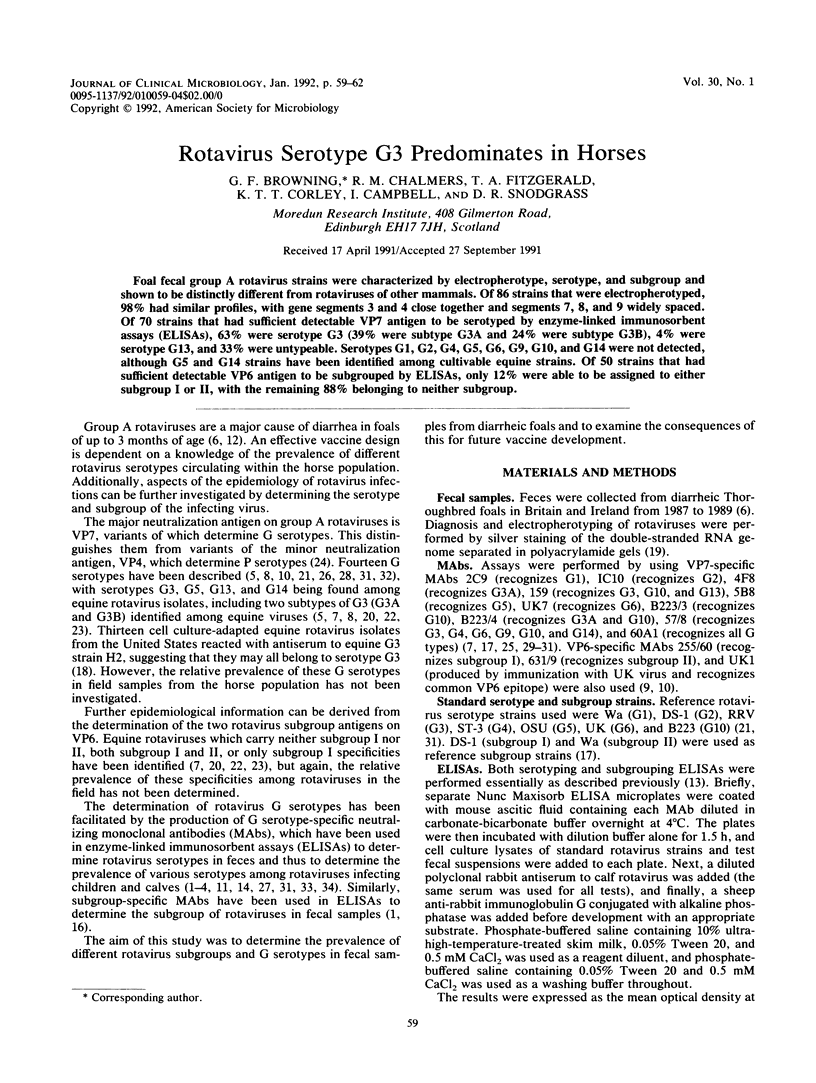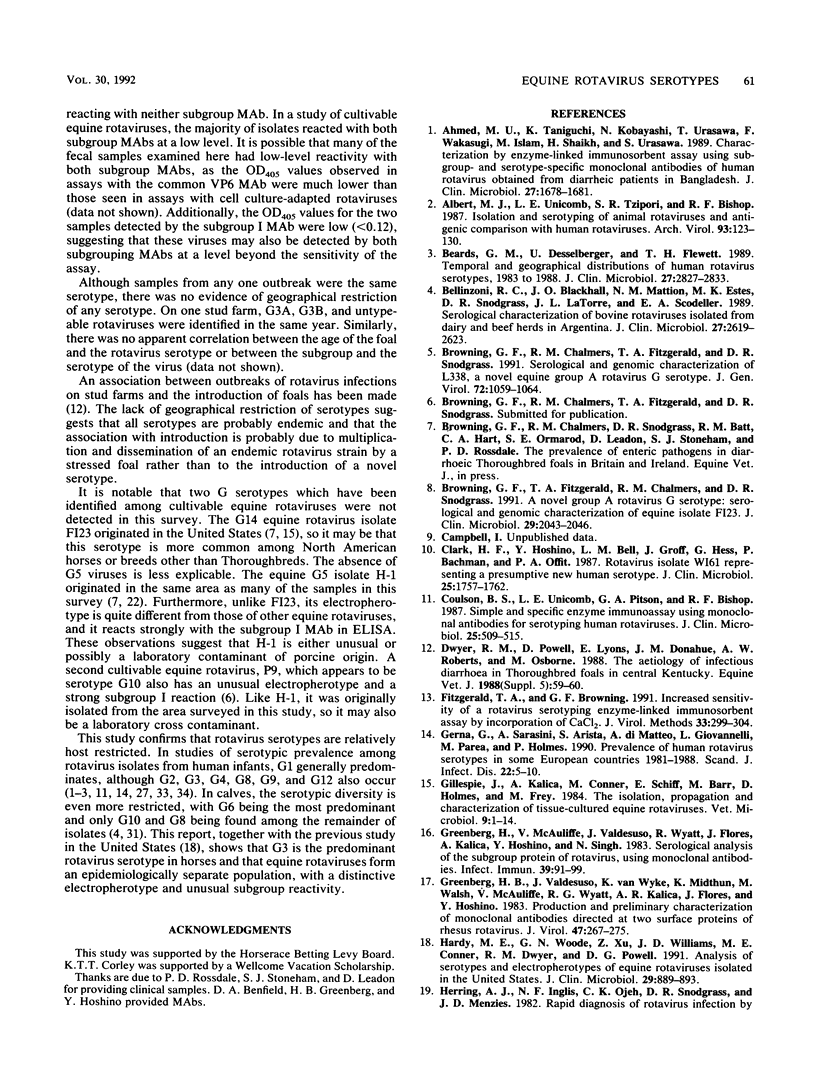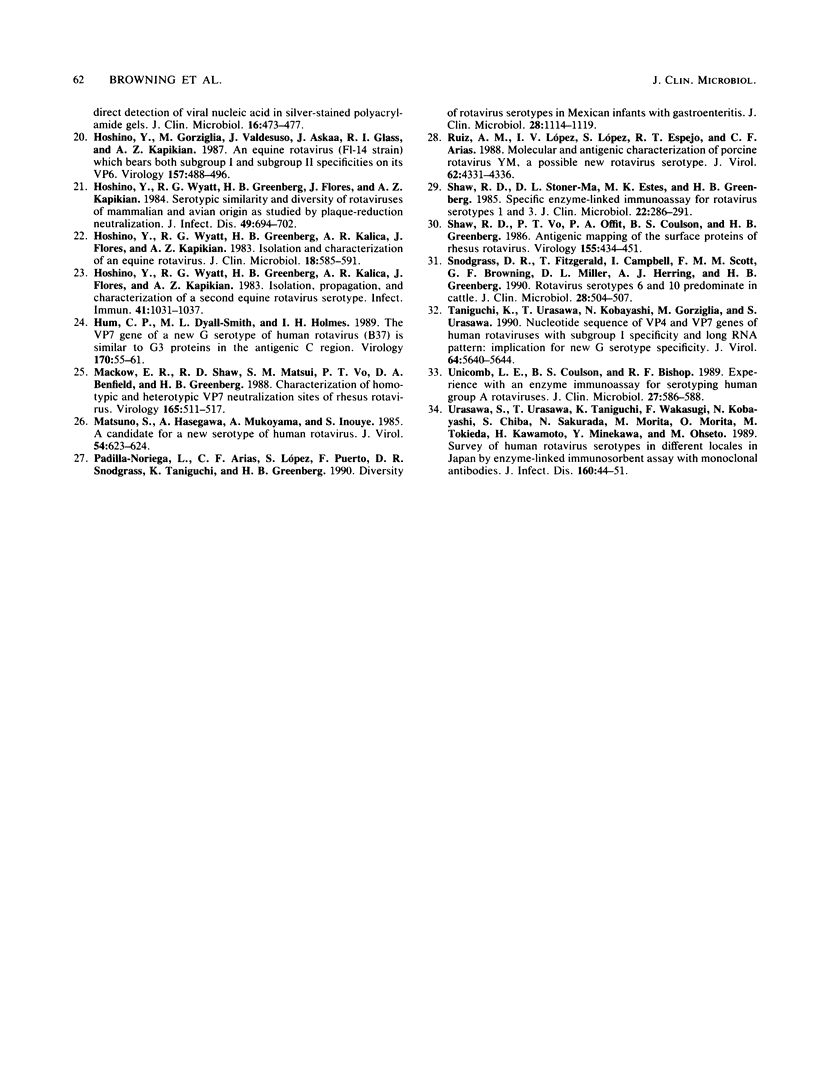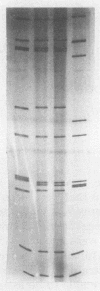Abstract
Foal fecal group A rotavirus strains were characterized by electropherotype, serotype, and subgroup and shown to be distinctly different from rotaviruses of other mammals. Of 86 strains that were electropherotyped, 98% had similar profiles, with gene segments 3 and 4 close together and segments 7, 8, and 9 widely spaced. Of 70 strains that had sufficient detectable VP7 antigen to be serotyped by enzyme-linked immunosorbent assays (ELISAs), 63% were serotype G3 (39% were subtype G3A and 24% were subtype G3B), 4% were serotype G13, and 33% were untypeable. Serotypes G1, G2, G4, G5, G6, G9, G10, and G14 were not detected, although G5 and G14 strains have been identified among cultivable equine strains. Of 50 strains that had sufficient detectable VP6 antigen to be subgrouped by ELISAs, only 12% were able to be assigned to either subgroup I or II, with the remaining 88% belonging to neither subgroup.
Full text
PDF



Images in this article
Selected References
These references are in PubMed. This may not be the complete list of references from this article.
- Ahmed M. U., Taniguchi K., Kobayashi N., Urasawa T., Wakasugi F., Islam M., Shaikh H., Urasawa S. Characterization by enzyme-linked immunosorbent assay using subgroup- and serotype-specific monoclonal antibodies of human rotavirus obtained from diarrheic patients in Bangladesh. J Clin Microbiol. 1989 Jul;27(7):1678–1681. doi: 10.1128/jcm.27.7.1678-1681.1989. [DOI] [PMC free article] [PubMed] [Google Scholar]
- Albert M. J., Unicomb L. E., Tzipori S. R., Bishop R. F. Isolation and serotyping of animal rotaviruses and antigenic comparison with human rotaviruses. Brief report. Arch Virol. 1987;93(1-2):123–130. doi: 10.1007/BF01313898. [DOI] [PubMed] [Google Scholar]
- Beards G. M., Desselberger U., Flewett T. H. Temporal and geographical distributions of human rotavirus serotypes, 1983 to 1988. J Clin Microbiol. 1989 Dec;27(12):2827–2833. doi: 10.1128/jcm.27.12.2827-2833.1989. [DOI] [PMC free article] [PubMed] [Google Scholar]
- Bellinzoni R. C., Blackhall J. O., Mattion N. M., Estes M. K., Snodgrass D. R., LaTorre J. L., Scodeller E. A. Serological characterization of bovine rotaviruses isolated from dairy and beef herds in Argentina. J Clin Microbiol. 1989 Nov;27(11):2619–2623. doi: 10.1128/jcm.27.11.2619-2623.1989. [DOI] [PMC free article] [PubMed] [Google Scholar]
- Browning G. F., Chalmers R. M., Fitzgerald T. A., Snodgrass D. R. Serological and genomic characterization of L338, a novel equine group A rotavirus G serotype. J Gen Virol. 1991 May;72(Pt 5):1059–1064. doi: 10.1099/0022-1317-72-5-1059. [DOI] [PubMed] [Google Scholar]
- Browning G. F., Fitzgerald T. A., Chalmers R. M., Snodgrass D. R. A novel group A rotavirus G serotype: serological and genomic characterization of equine isolate FI23. J Clin Microbiol. 1991 Sep;29(9):2043–2046. doi: 10.1128/jcm.29.9.2043-2046.1991. [DOI] [PMC free article] [PubMed] [Google Scholar]
- Clark H. F., Hoshino Y., Bell L. M., Groff J., Hess G., Bachman P., Offit P. A. Rotavirus isolate WI61 representing a presumptive new human serotype. J Clin Microbiol. 1987 Sep;25(9):1757–1762. doi: 10.1128/jcm.25.9.1757-1762.1987. [DOI] [PMC free article] [PubMed] [Google Scholar]
- Coulson B. S., Unicomb L. E., Pitson G. A., Bishop R. F. Simple and specific enzyme immunoassay using monoclonal antibodies for serotyping human rotaviruses. J Clin Microbiol. 1987 Mar;25(3):509–515. doi: 10.1128/jcm.25.3.509-515.1987. [DOI] [PMC free article] [PubMed] [Google Scholar]
- Fitzgerald T. A., Browning G. F. Increased sensitivity of a rotavirus serotyping enzyme-linked immunosorbent assay by the incorporation of CaCl2. J Virol Methods. 1991 Aug;33(3):299–304. doi: 10.1016/0166-0934(91)90029-y. [DOI] [PubMed] [Google Scholar]
- Gerna G., Sarasini A., Arista S., di Matteo A., Giovannelli L., Parea M., Halonen P. Prevalence of human rotavirus serotypes in some European countries 1981-1988. Scand J Infect Dis. 1990;22(1):5–10. doi: 10.3109/00365549009023112. [DOI] [PubMed] [Google Scholar]
- Gillespie J., Kalica A., Conner M., Schiff E., Barr M., Holmes D., Frey M. The isolation, propagation and characterization of tissue-cultured equine rotaviruses. Vet Microbiol. 1984 Feb;9(1):1–14. doi: 10.1016/0378-1135(84)90074-9. [DOI] [PubMed] [Google Scholar]
- Greenberg H. B., Valdesuso J., van Wyke K., Midthun K., Walsh M., McAuliffe V., Wyatt R. G., Kalica A. R., Flores J., Hoshino Y. Production and preliminary characterization of monoclonal antibodies directed at two surface proteins of rhesus rotavirus. J Virol. 1983 Aug;47(2):267–275. doi: 10.1128/jvi.47.2.267-275.1983. [DOI] [PMC free article] [PubMed] [Google Scholar]
- Greenberg H., McAuliffe V., Valdesuso J., Wyatt R., Flores J., Kalica A., Hoshino Y., Singh N. Serological analysis of the subgroup protein of rotavirus, using monoclonal antibodies. Infect Immun. 1983 Jan;39(1):91–99. doi: 10.1128/iai.39.1.91-99.1983. [DOI] [PMC free article] [PubMed] [Google Scholar]
- Hardy M. E., Woode G. N., Xu Z. C., Williams J. D., Conner M. E., Dwyer R. M., Powell D. G. Analysis of serotypes and electropherotypes of equine rotaviruses isolated in the United States. J Clin Microbiol. 1991 May;29(5):889–893. doi: 10.1128/jcm.29.5.889-893.1991. [DOI] [PMC free article] [PubMed] [Google Scholar]
- Hoshino Y., Gorziglia M., Valdesuso J., Askaa J., Glass R. I., Kapikian A. Z. An equine rotavirus (FI-14 strain) which bears both subgroup I and subgroup II specificities on its VP6. Virology. 1987 Apr;157(2):488–496. doi: 10.1016/0042-6822(87)90291-1. [DOI] [PubMed] [Google Scholar]
- Hoshino Y., Wyatt R. G., Greenberg H. B., Flores J., Kapikian A. Z. Serotypic similarity and diversity of rotaviruses of mammalian and avian origin as studied by plaque-reduction neutralization. J Infect Dis. 1984 May;149(5):694–702. doi: 10.1093/infdis/149.5.694. [DOI] [PubMed] [Google Scholar]
- Hoshino Y., Wyatt R. G., Greenberg H. B., Kalica A. R., Flores J., Kapikian A. Z. Isolation and characterization of an equine rotavirus. J Clin Microbiol. 1983 Sep;18(3):585–591. doi: 10.1128/jcm.18.3.585-591.1983. [DOI] [PMC free article] [PubMed] [Google Scholar]
- Hoshino Y., Wyatt R. G., Greenberg H. B., Kalica A. R., Flores J., Kapikian A. Z. Isolation, propagation, and characterization of a second equine rotavirus serotype. Infect Immun. 1983 Sep;41(3):1031–1037. doi: 10.1128/iai.41.3.1031-1037.1983. [DOI] [PMC free article] [PubMed] [Google Scholar]
- Hum C. P., Dyall-Smith M. L., Holmes I. H. The VP7 gene of a new G serotype of human rotavirus (B37) is similar to G3 proteins in the antigenic c region. Virology. 1989 May;170(1):55–61. doi: 10.1016/0042-6822(89)90351-6. [DOI] [PubMed] [Google Scholar]
- Mackow E. R., Shaw R. D., Matsui S. M., Vo P. T., Benfield D. A., Greenberg H. B. Characterization of homotypic and heterotypic VP7 neutralization sites of rhesus rotavirus. Virology. 1988 Aug;165(2):511–517. doi: 10.1016/0042-6822(88)90595-8. [DOI] [PubMed] [Google Scholar]
- Matsuno S., Hasegawa A., Mukoyama A., Inouye S. A candidate for a new serotype of human rotavirus. J Virol. 1985 May;54(2):623–624. doi: 10.1128/jvi.54.2.623-624.1985. [DOI] [PMC free article] [PubMed] [Google Scholar]
- Padilla-Noriega L., Arias C. F., López S., Puerto F., Snodgrass D. R., Taniguchi K., Greenberg H. B. Diversity of rotavirus serotypes in Mexican infants with gastroenteritis. J Clin Microbiol. 1990 Jun;28(6):1114–1119. doi: 10.1128/jcm.28.6.1114-1119.1990. [DOI] [PMC free article] [PubMed] [Google Scholar]
- Ruiz A. M., López I. V., López S., Espejo R. T., Arias C. F. Molecular and antigenic characterization of porcine rotavirus YM, a possible new rotavirus serotype. J Virol. 1988 Nov;62(11):4331–4336. doi: 10.1128/jvi.62.11.4331-4336.1988. [DOI] [PMC free article] [PubMed] [Google Scholar]
- Shaw R. D., Stoner-Ma D. L., Estes M. K., Greenberg H. B. Specific enzyme-linked immunoassay for rotavirus serotypes 1 and 3. J Clin Microbiol. 1985 Aug;22(2):286–291. doi: 10.1128/jcm.22.2.286-291.1985. [DOI] [PMC free article] [PubMed] [Google Scholar]
- Shaw R. D., Vo P. T., Offit P. A., Coulson B. S., Greenberg H. B. Antigenic mapping of the surface proteins of rhesus rotavirus. Virology. 1986 Dec;155(2):434–451. doi: 10.1016/0042-6822(86)90205-9. [DOI] [PubMed] [Google Scholar]
- Snodgrass D. R., Fitzgerald T., Campbell I., Scott F. M., Browning G. F., Miller D. L., Herring A. J., Greenberg H. B. Rotavirus serotypes 6 and 10 predominate in cattle. J Clin Microbiol. 1990 Mar;28(3):504–507. doi: 10.1128/jcm.28.3.504-507.1990. [DOI] [PMC free article] [PubMed] [Google Scholar]
- Taniguchi K., Urasawa T., Kobayashi N., Gorziglia M., Urasawa S. Nucleotide sequence of VP4 and VP7 genes of human rotaviruses with subgroup I specificity and long RNA pattern: implication for new G serotype specificity. J Virol. 1990 Nov;64(11):5640–5644. doi: 10.1128/jvi.64.11.5640-5644.1990. [DOI] [PMC free article] [PubMed] [Google Scholar]
- Unicomb L. E., Coulson B. S., Bishop R. F. Experience with an enzyme immunoassay for serotyping human group A rotaviruses. J Clin Microbiol. 1989 Mar;27(3):586–588. doi: 10.1128/jcm.27.3.586-588.1989. [DOI] [PMC free article] [PubMed] [Google Scholar]
- Urasawa S., Urasawa T., Taniguchi K., Wakasugi F., Kobayashi N., Chiba S., Sakurada N., Morita M., Morita O., Tokieda M. Survey of human rotavirus serotypes in different locales in Japan by enzyme-linked immunosorbent assay with monoclonal antibodies. J Infect Dis. 1989 Jul;160(1):44–51. doi: 10.1093/infdis/160.1.44. [DOI] [PubMed] [Google Scholar]



